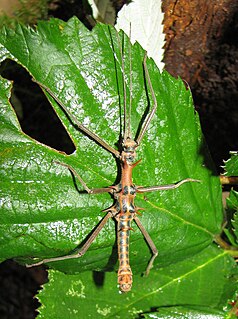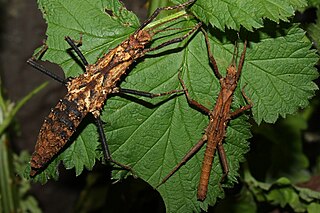
Heteropteryx is a monotypic genus of stick insects containing Heteropteryx dilatata as the only described species. and gives its name to the family of the Heteropterygidae. Their only species may be known as jungle nymph, Malaysian stick insect, Malaysian wood nymph, Malayan jungle nymph, or Malayan wood nymph and because of their size it is commonly kept in zoological institutions and private terrariums of insect lovers. It originates in Malay Archipelago, more precisely on the Malay Peninsula and Borneo and is nocturnal.

Pylaemenes is a genus of stick insects in the family Heteropterygidae and subfamily Dataminae. It combines small to medium-sized, often brightly colored Phasmatodea species. Their representatives are found in large parts of Southeast Asia.

Heteropterygini is the only tribe within the subfamily of the Heteropteryginae from the order of the Phasmatodea in the family Heteropterygidae. With 19 representatives described, this subfamily represents both the species-poorest and that of the three subfamilies, to which the largest and most striking species are counted.

Epidares nolimetangere, the touch-me-not stick insect, is an insect species from the order of the Phasmatodea and the only representative of the genus Epidares. The species name nolimetangere comes from Latin and means "don't touch me". It refers to the prickly appearance of the animals.

The genus Dares, which is mainly native to Borneo, combines relatively small and mostly dark-colored Phasmatodea species.

Hoploclonia is the only genus of the tribe Hoplocloniini and brings together relatively small and darkly colored Phasmatodea species.

The genus Tisamenus native to the Philippines combines small to medium-sized species of stick insects.

Aretaon is a genus of stick insects native to Borneo and the Philippine island Palawan.

Aretaon asperrimus is a species of insect in the Aretaon genus of the Phasmatodea order. The sometimes used common name thorny stick insect is a bit misleading, since the species does not correspond to the typical stick-like habitus and many other species are thorny as well.

Dares murudensis is a relatively small species of stick insect. Like most other members of the genus Dares, the species is native to Borneo.

Dares philippinensis is a species of stick insects. This species is not native to Borneo like most other members of the genus Dares, but to the Philippine island Palawan.

Dares verrucosus is a species of stick insects. Like most other members of the genus Dares, the species is native to Borneo, more precisely in the north of the island.

Dares validispinus is a species of stick insects. Like most other members of the genus Dares, the species is native to Borneo, more precisely in the northwest of the island.

Dares ulula is a species of stick insects. Like most other members of the genus Dares, the species is native to Borneo, more precisely in the northwest of the island. The males are extremely prickly even for the representatives of the genus Orestes. Females are colored with a relatively high contrast.

Aretaon muscosus is a stick insect species from the family Heteropterygidae, which is native to Borneo.

Trachyaretaon carmelae is a species of stick insects. Even if there was no formal synonymisation, Trachyaretaon brueckneri is generally used as its synonym.

Tisamenus serratorius is a stick insect species that occurs on the Philippine island Luzon.

Tisamenus deplanatus is a stick insect species native to the Philippine islands Luzon and Mindanao occurs.

Hoploclonia cuspidata is a stick insect species native to the north of Borneo and is also called Brunei Hoploclonia stick insect.

Hoploclonia abercrombiei is a stick insect species known from the northwest of Borneo, more precisely from only one place in the Malay state Sarawak.

















